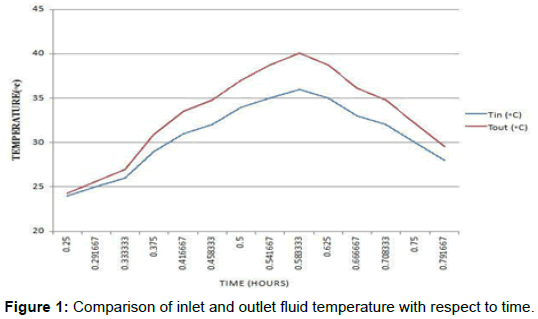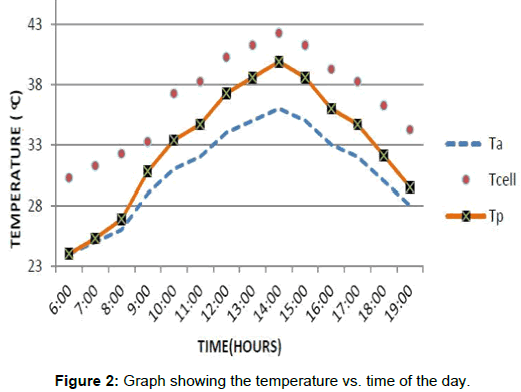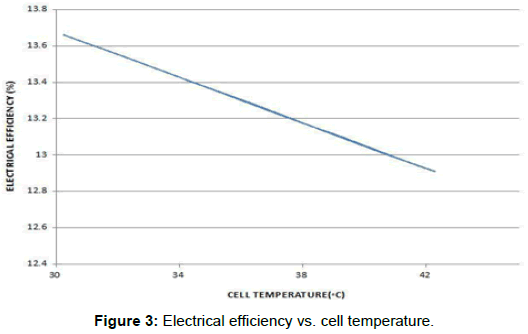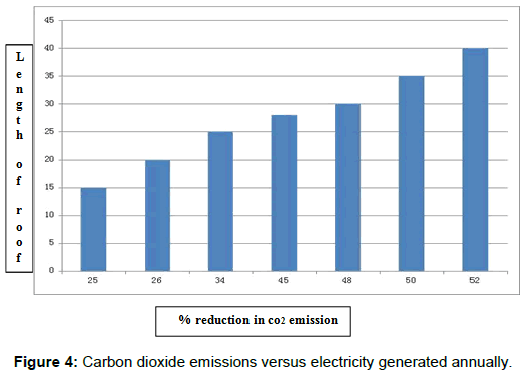Environmentally Sustainable Roof Integrated Solar Conservatory System
Received: 22-Feb-2018 / Accepted Date: 02-Mar-2018 / Published Date: 07-Mar-2018 DOI: 10.4172/2576-1463.1000192
Abstract
It is a well-known fact that the efficiency of the photovoltaic decreases with the increase in the operating Solar PV panel temperature. Solar Photovoltaic/Thermal (PV/T) technology is a newer solar conversion technology which would convert the incident solar radiation into usable electrical and thermal energy at the same time. It is observed that solar PV modules have low efficiencies of not more than 20% that means 80% or more of the total incoming solar radiation is not utilized and converted as heat which is utilized in raising the operating temperature of the module. This heat can be removed by passing water from the rear surface of the absorber plate which is the Solar PV panel. The absorbed heat can be used in low temperature application like drying, space heating, etc., Thus it is the aim of the present study to go in for the thermal analysis of building integrated solar PV-T system as a means of energy conservation and environmentally sustainable solution with respect to carbon dioxide emissions.
Keywords: Solar Photovoltaic/Thermal; Solar radiation; Building integrated; Normal operating Solar PV panel temperature; Absorber plate; Environmentally sustainable
Introduction
To understand the environmental and ecological challenges that face humanity, and the economic implications of an adequate response to these challenges, it is necessary to reconceptualize the relation between the economy and the environment [1]. The development of sources of clean energy is an essential part of the approach to improve energy efficiency and also cut carbon emissions. Solar energy from the sun yields no emissions which aids in contending greenhouse gases and global warming. Photovoltaic thermal hybrid solar collectors, sometimes known as hybrid PV/T systems or PVT, are systems that convert solar radiation into thermal and electrical energy [2].
Photovoltaic panels convert solar radiation to electricity with peak efficiencies of 5%-20% corresponding to the type of cell [3]. Considering almost 90% of our energy is derived from burning fossil fuels, the carbon emission profile is similar [4]. Greenhouse gas emissions from buildings primarily arise from their consumption of fossil-fuel based energy, both through the direct use of fossil fuels and through the use of electricity which has been generated from fossil fuels. Building envelope materials including the wall, roof u factors, insulation, glazing performance and sunshades etc., in building orientation based on east, west, north and south facades (faces), in the lighting includes reduction of lighting power density and finally energy efficient HVAC systems [5]. Thus the aim of the present work is to do the thermal analysis of a roof integrated solar PVT system and also find out the percentage reduction in carbon emission annually [6-10].
Experimental
Solar conservatory roof top system considered
Solar PVT roof top system is fitted to a roof space to produce electricity and also to tap the heat which is used for low temperature applications as to heat the water in the home can be installed. The system considered in this study is a room of 1200 sq ft. floor area and the roof is a roof integrated solar PVT system. Water is used as the heat removing fluid and the heated hot water is used directly for low thermal applications. The PV/T roof top system is modeled such that to achieve maximum energy output by simultaneous electricity and heat generation and also to reduce the CO2 emission generated. The methods for the performance are taken from energy conscious buildings by Nayak and J. A. Prajapati. Table 1 shows the various solar PV/T system parameters considered.
| Description | Symbol | Value | Units |
|---|---|---|---|
| Ambient temperature | Ta | - | K |
| Inlet fluid temperature | Ti | - | K |
| Collector width | b | 0.65 | m |
| Collector area | Ac | 0.65 | m |
| Number of glass cover | n | 1 | - |
| Emittance of glass cover | εg | 0.88 | - |
| Emittance of plate | εp | 0.95 | - |
| Fluid flow rate | m | 0.02 | kg/s |
| Fluid thermal conductivity | Kfluid | 0.613 | - |
| Specific heat | Cp | 4180 | - |
| Transmittance | τ | 0.88 | - |
| Absorptance | α | 0.95 | - |
| Heat removal factor | FR | 0.965 | - |
Table 1: PV/T solar roof top system parameters.
Results and Discussion
Performance analysis
The specific operation condition is set from 6:00 h till 19:00 h. Data for the ambient temperature is collected from the local weather station for location Chennai which shows that at 6:00 h the ambient temperature is 24 degree Celsius and 28 degrees Celsius at 19:00 h with the peak at 36 degree Celsius 14:00 hours. The fluid flow rate is set to 0.02 kg/s. The inlet temperature of the fluid is considered equal to the ambient temperature. The temperature of the fluid increases with the increase in the ambient temperature.
Figure 1 shows variation in the inlet fluid temperature and the outlet fluid temperature with respect to time keeping the mass flow rate of water constant i.e. equal to 0.02 kg/s. The fluid is allowed to pass through the pipe from the back of the absorber plate. The fluid carries the excessive heat of the PV panel thus increasing the efficiency and the life the PV panel. The water can be circulated using pump or by natural circulation process. The hot water can be used for low temperature application such as cooking, bathing, washing, etc. Here it is assumed that Tin=Ta where Tin=the inlet fluid temperature and is the Ta=the ambient temperature, Tout is the outlet fluid temperature. The maximum outlet temperature is achieved at 14:00 h. The inlet fluid temperature is 36 degree Celsius and the outlet fluid temperature is 40.07 degree Celsius. The fluid temperature increases by 4.07 degree Celsius.
Figure 2 shows the plate temperature for the entire day. Cells are mounted on the absorber plate. Therefore the temperature of the cell is higher than the plate temperature. Temperature vs. time graph is plotted. It shows the maximum plate temperature is 39.88°C with cell temperature of 42.25°C at 14:00 h.
Figure 3 shows the electrical efficiency vs. Cell temperature graph. As the cell temperature increases, the efficiency of the panel decreases. Therefore it is necessary to remove the heat from the panel. This will not only increase the efficiency of the panel, but will also increase the lifespan of the panel.
To overcome this problem, PVT systems are introduced. The water passes over the PV back surface preventing the panel from overheating. Also hot water demand can be met using PVT system. This hot water can be used for low temperature application such as cooking, bathing, washing, etc. Thus it decreases the load on the power plant sectors. It can be seen from Figure 4 that the reduction in the CO2 emission increases as the length of the roof increases.
Conclusion
The study performed under the reduced cell temperature conditions gives thermal efficiency of 52.45% with a corresponding cell efficiency of 12.91%.
PV/T regulates panel temperature using a fluid cooling system creating a balanced system trading off between PV efficiency and thermal output.
Using this principle it is possible to obtain a higher electrical yield compared with equivalent base case and PV system and enough free heat to offset a low energy building’s annual heating requirements. Because of its cooling-effect on the PV module, this system has a higher efficiency at a lower cost price than separate similar efficiency of PV and Solar Thermal systems.
References
- Forstater M (2003) Public employment and environmental sustainability. J Post Keynes Econ 25: 385-406.
- Zondag (2008) Flat-plate PV-thermal collectors and systems: A review. Renewable and Sustainable Energy Reviews 12: 891-959.
- Prakash (1994) Transient analysis of a photovoltaic-thermal solar collector for cogeneration of electricity & hot air/water. Energy Conversion Management 35: 967-972.
- Energy White Paper (2003) Our Energy Future-Creating A Low Carbon Economy, DTI, UK.
- Energy Conservation Building Code User Guides (2009) Bureau of Energy Efficiency, India.
- Sustainable Energy for Rural India (2008) National Academy of Agricultural Sciences, India.
- Consumer Energy Information (2002) EREC Reference Briefs, U.S Department of Energy.
- Seng TP, Fan J, Hua GL (2012) Solar Photovoltaic/Thermal (PVT) Test-bed. International Congress on Informatics, Environment, Energy and Applications-IEEA 201, IPCSIT, Singapore.
- NYSERDA (2009) Introduction to solar energy applications for agriculture. New York State Energy Research Development Authority, New York.
- Van Helden WGJ, Van Zolingen RJC, Zondag HA (2004) PV Thermal Systems: PV panels supplying renewable electricity and heat. Photovoltaics: Research and Applications 12: 415-426.
Citation: Pardeshi P, Singh V (2018) Environmentally Sustainable Roof Integrated Solar Conservatory System. Innov Ener Res 7: 192. DOI: 10.4172/2576-1463.1000192
Copyright: © 2018 Pardeshi P, et al. This is an open-access article distributed under the terms of the Creative Commons Attribution License, which permits unrestricted use, distribution, and reproduction in any medium, provided the original author and source are credited.
Select your language of interest to view the total content in your interested language
Share This Article
Recommended Journals
Open Access Journals
Article Tools
Article Usage
- Total views: 4750
- [From(publication date): 0-2018 - Dec 10, 2025]
- Breakdown by view type
- HTML page views: 3860
- PDF downloads: 890




